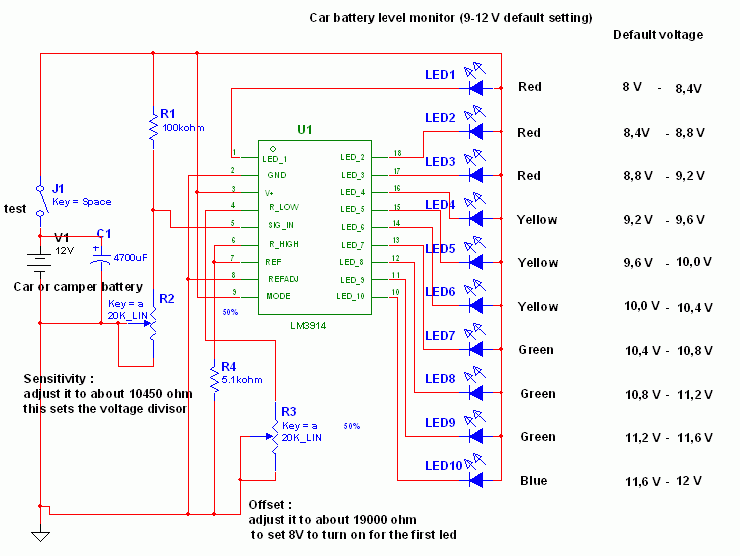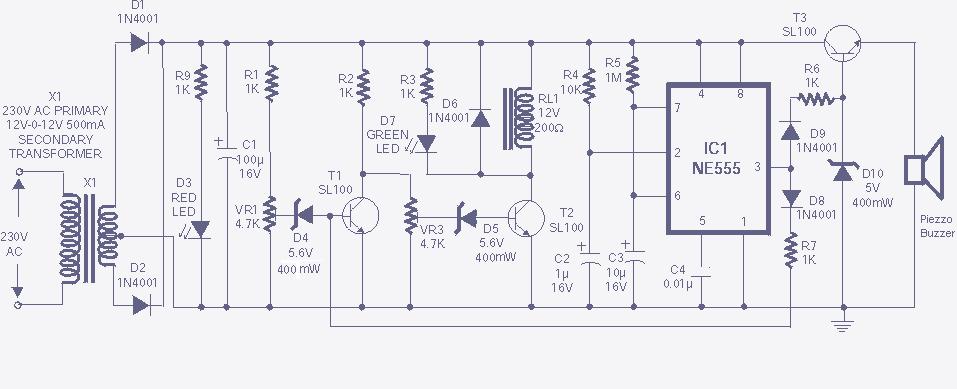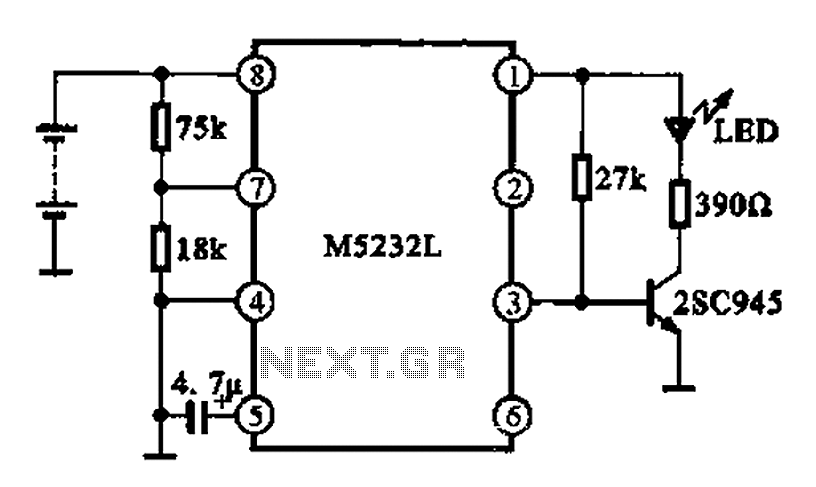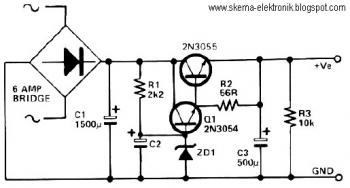
Low Cost Battery Condition IndicatorCircuit
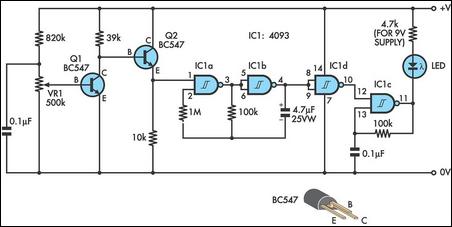
This design integrates power-on and low-battery indications, capable of operating with any battery voltage up to 15V. It features a very low current drain of 2mA or less and costs less than $3.50 with new components. When the battery voltage exceeds a predetermined minimum, power-on is indicated by what appears to be a continuously lit LED. In reality, the LED is pulsed by a free-running relaxation oscillator created by IC1c, one gate of a 4093 CMOS quad Schmitt NAND. The oscillator's frequency should be at least 50Hz to give the illusion of a steady light while consuming significantly less average current than a continuously lit LED. The series resistor for the LED must be selected based on the battery voltage to limit the current to a safe value, or alternatively, a fixed resistor can be used in conjunction with a series trimpot for flexibility. Low battery voltage is indicated by the LED pulsing at approximately 1Hz. The battery voltage is monitored by transistor Q1 and trimpot VR1. When the voltage at the base of Q1 drops below 0.6V, Q1 turns off, and Q2 turns on, activating a 2-gate oscillator formed by IC1a and IC1b, which operates at 1Hz. The pulses from this oscillator are inverted by IC1d to control the LED oscillator's operation. Calibration can be performed using a variable bench power supply set to the lowest acceptable battery voltage. The circuit is powered up, and VR1 is adjusted until the LED pulses once per second. Author: Peter Wilson - Copyright: Silicon Chip
This circuit design is an effective solution for indicating both power-on status and low battery conditions in battery-operated devices. The use of a 4093 CMOS quad Schmitt NAND allows for efficient operation with minimal power consumption, making it suitable for applications where battery life is critical. The oscillator design, which operates at a frequency of at least 50Hz, ensures that the LED appears continuously lit to the human eye while actually drawing significantly less current than a conventional LED setup.
The choice of a series resistor or a combination of a fixed resistor and trimpot for LED current limiting provides flexibility in adapting to various battery voltages. The low-battery indication mechanism, which causes the LED to pulse at about 1Hz, is a clear and effective way to alert users to the need for a battery replacement.
Transistor Q1 plays a crucial role in monitoring the battery voltage. By using a trimpot (VR1), precise calibration is achievable, allowing the circuit to be fine-tuned to activate the low-battery indicator at the desired voltage threshold. The transition from the LED being continuously lit to pulsing at 1Hz is managed through the activation of Q2, which triggers the 2-gate oscillator when battery voltage falls below the specified threshold.
Overall, this design exemplifies a well-thought-out approach to battery management in electronic devices, balancing performance, cost, and power efficiency. The components selected are readily available, and the circuit can be easily implemented in various applications requiring reliable power management indicators.This design combines power-on and low-battery indication, can operate with any battery voltage up to 15V, has very low current drain (2mA or less) and costs less than $3. 50 with new parts. When the battery voltage is above a predetermined minimum, power on is indicated by what appears to be a steadily lit LED.
In fact, the LED is being pulsed by a free-running relaxation oscillator formed by IC1c, one gate of a 4093 CMOS quad Schmitt NAND. The frequency of this oscillator should be at least 50Hz, so that it appears to be continuously on while at the same time drawing far less average current than a steadily lit LED. The series resistor for the LED needs to be selected for each battery voltage, to limit the current to a safe vale or you could use a fixed resistor and a series trimpot for flexibility.
Low battery voltage is indicated by the LED pulsing at around 1Hz. The battery voltage is monitored by transistor Q1 and trimpot VR1. Once the voltage at its base falls below 0. 6V, Q1 turns off and Q2 turns on to enable the 2-gate oscillator formed by IC1a and IC1b, which runs at 1Hz. The pulses from this oscillator are inverted by IC1d to gate the LED oscillator on and off. Calibration can be done with a variable bench power supply set to the lowest battery voltage you will accept.
Power up the circuit and adjust VR1 until the LED pulses once per second. Author: Peter Wilson - Copyright: Silicon Chip 🔗 External reference
This circuit design is an effective solution for indicating both power-on status and low battery conditions in battery-operated devices. The use of a 4093 CMOS quad Schmitt NAND allows for efficient operation with minimal power consumption, making it suitable for applications where battery life is critical. The oscillator design, which operates at a frequency of at least 50Hz, ensures that the LED appears continuously lit to the human eye while actually drawing significantly less current than a conventional LED setup.
The choice of a series resistor or a combination of a fixed resistor and trimpot for LED current limiting provides flexibility in adapting to various battery voltages. The low-battery indication mechanism, which causes the LED to pulse at about 1Hz, is a clear and effective way to alert users to the need for a battery replacement.
Transistor Q1 plays a crucial role in monitoring the battery voltage. By using a trimpot (VR1), precise calibration is achievable, allowing the circuit to be fine-tuned to activate the low-battery indicator at the desired voltage threshold. The transition from the LED being continuously lit to pulsing at 1Hz is managed through the activation of Q2, which triggers the 2-gate oscillator when battery voltage falls below the specified threshold.
Overall, this design exemplifies a well-thought-out approach to battery management in electronic devices, balancing performance, cost, and power efficiency. The components selected are readily available, and the circuit can be easily implemented in various applications requiring reliable power management indicators.This design combines power-on and low-battery indication, can operate with any battery voltage up to 15V, has very low current drain (2mA or less) and costs less than $3. 50 with new parts. When the battery voltage is above a predetermined minimum, power on is indicated by what appears to be a steadily lit LED.
In fact, the LED is being pulsed by a free-running relaxation oscillator formed by IC1c, one gate of a 4093 CMOS quad Schmitt NAND. The frequency of this oscillator should be at least 50Hz, so that it appears to be continuously on while at the same time drawing far less average current than a steadily lit LED. The series resistor for the LED needs to be selected for each battery voltage, to limit the current to a safe vale or you could use a fixed resistor and a series trimpot for flexibility.
Low battery voltage is indicated by the LED pulsing at around 1Hz. The battery voltage is monitored by transistor Q1 and trimpot VR1. Once the voltage at its base falls below 0. 6V, Q1 turns off and Q2 turns on to enable the 2-gate oscillator formed by IC1a and IC1b, which runs at 1Hz. The pulses from this oscillator are inverted by IC1d to gate the LED oscillator on and off. Calibration can be done with a variable bench power supply set to the lowest battery voltage you will accept.
Power up the circuit and adjust VR1 until the LED pulses once per second. Author: Peter Wilson - Copyright: Silicon Chip 🔗 External reference
